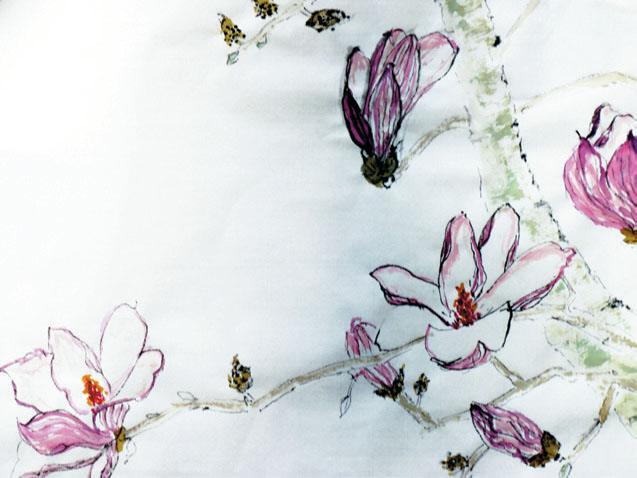Brush painting has permeated all of my work,” says Bernice Faegenburg whose solo show will be at Viridian Artists Gallery, April 28-May 16. While the artist’s brush paintings on rice paper are delicate and refined, her large scale pieces are dynamic, lively, and bold. Yet there is a recurring technique that unites the two—Asian or more often Japanese-style brush work using traditional sumi (black) ink.
In Faegenburg’s house in Roslyn, Long Island, every conceivable space is covered with piles of brush paintings. She also has stacks of canvases lining her walls while her dining room table in front of a large bay window, where she prefers to work, is barely visible. As in her East Hampton house, there is a studio but it too is covered floor to ceiling with past work. In the last five years Faegenburg has continued to paint large works, some even huge canvas triptychs, as well as small rice paper paintings in ink and watercolors.

It’s not just size that differentiates her work on canvas and paper. The large canvas paintings, that she calls “wild looking,” are robust acrylics with mixed media. They tend to have an overall underpainting, a geometric grid, silk screening right on the canvas, dramatic brush strokes, and on occasion, transparent rice paper glued to the canvas. Also, they are brightly painted and far from her nearly monochrome rice paper paintings.
Mastering the art of brush painting on rice paper requires rigorous training and discipline —and in Faegenburg’s case a willingness to discard work that doesn’t measure up. She tosses out far more than she keeps. The challenges would defeat even the most intrepid painter. For a start, you have to load the brush with just the right amount of sumi ink, the same type used in Asian calligraphy. Then, you have to know how to create nuances with the black ink, from soft barely visible shades to strokes as black as night. To capture your image, whether it is a bamboo branch, cherry trees, or a plum blossom, it is necessary to use as few strokes as possible. Rice paper is highly absorbent so another challenge is not to make the brush too wet. In the end, what Faegenburg seeks is a harmonic composition of line, shading, and some color.

All three harmonies are visible in her wisteria painting, inspired by vines growing in her backyard. “I always start with the black lines,” she says adding that in this instance they are very free and wavy.” The vine leaves are various shades of green while the wisteria blooms range from almost transparent to dark lavender. “Once the painting was finished and dry, I used a light blue watercolor that fades away gently,” she says. All the nuances of color give the hanging vines a sense of movement, as if they were swaying in a gentle breeze.
This same movement is evident in Faegenburg’s bamboo paintings where she concentrates on the distribution of light, shade, and color contrasts to create a lively image. “I like to imply a slight wind in my bamboo paintings,” says the artist who might finish a brush painting in a day. Using long vertical lines to show movement, the artist is striving for a fresh and lively effect. Some of her other bamboo paintings are more subdued and have a meditative quality.
“What I try to do is get to the essence of things,” says Faegenburg. “In Asian art, there is always a precise way of doing something. But I believe you have to be a bit free. You have to show yourself. Although it seems as if I am always painting bamboo, a major theme in my work, I am constantly reinterpreting, responding to what I see before me and what my brush stroke allows me to do.”





